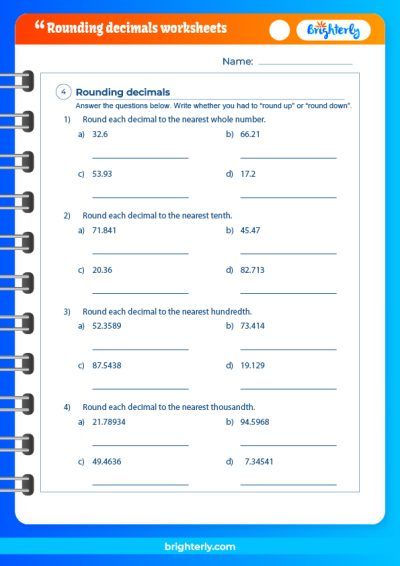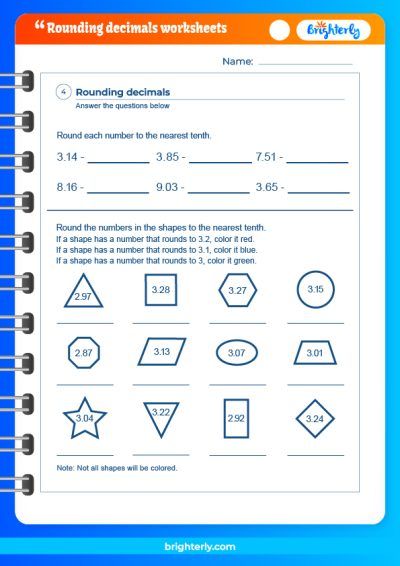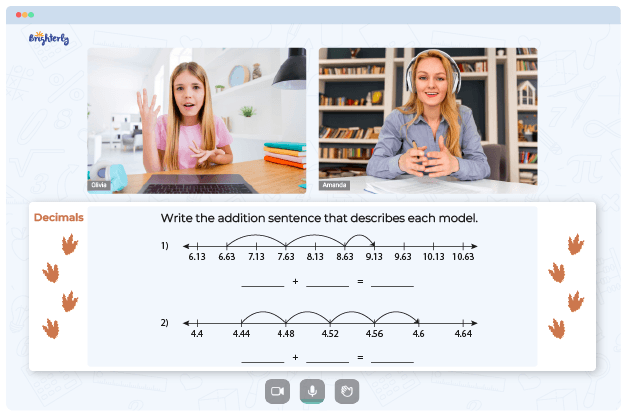Rounding Decimals – Definition with Examples
Created on Dec 20, 2023
Updated on January 7, 2024
Welcome to another exciting topic on Brighterly, where we make learning math fun and engaging for children. Today, we’re diving into the world of rounding decimals. This is a fundamental concept in mathematics that helps simplify complex numbers for easier understanding and calculation.
Rounding decimals involves reducing the number of digits in a decimal while trying to keep its value close to the original. It’s like approximating, but with a rule that tells us how to do it systematically. This process is particularly useful in real-life scenarios where precision isn’t as important as simplicity. For example, if you’re estimating the cost of groceries, calculating the distance of a road trip, or determining the average score in a game, rounding decimals can make the task much easier.
At Brighterly, we believe in the power of examples. So, let’s consider the number 3.14159. If we round it to the nearest whole number, we get 3. If we round it to the nearest tenth, we get 3.1. And if we round it to the nearest hundredth, we get 3.14. As you can see, each rounding step makes the number simpler, yet it remains close to the original value.
Rounding Decimals
Rounding decimals is a fundamental concept in mathematics that helps simplify complex numbers for easier understanding and calculation. It involves reducing the number of digits in a decimal while trying to keep its value close to the original. This process is particularly useful in real-life scenarios where precision isn’t as important as simplicity. For example, if you’re estimating the cost of groceries or calculating the distance of a road trip, rounding decimals can make the task much easier.
Rounding to the Nearest Whole
When rounding to the nearest whole number, we look at the digit in the tenths place. If it’s 5 or more, we round up the whole number part, and if it’s less than 5, we keep the whole number part as it is. For example, rounding 3.7 to the nearest whole number gives us 4, while rounding 3.4 gives us 3. This method is often used in financial calculations where cents are not considered.
Rounding to the Nearest Tenths
Rounding to the nearest tenths involves looking at the digit in the hundredths place. If this digit is 5 or more, we round up the number in the tenths place. If it’s less than 5, we keep the number in the tenths place as it is. For instance, rounding 3.74 to the nearest tenth gives us 3.7, while rounding 3.75 gives us 3.8. This method is often used in scientific calculations where a higher degree of precision is required.
Rounding to the Nearest Hundredths
When rounding to the nearest hundredths, we look at the digit in the thousandths place. If this digit is 5 or more, we round up the number in the hundredths place. If it’s less than 5, we keep the number in the hundredths place as it is. For example, rounding 3.745 to the nearest hundredth gives us 3.75, while rounding 3.744 gives us 3.74. This method is often used in engineering and physics where a high degree of accuracy is needed.
What is Rounding Decimals Calculator?
A Rounding Decimals Calculator is a digital tool that automatically rounds decimal numbers to the nearest whole number, tenth, hundredth, or any other specified place value. It’s a handy tool for students, teachers, engineers, and anyone who frequently works with decimal numbers. These calculators are widely available online and can be used for free.
You can find the answers and more practice questions in our Rounding Decimals Practice Worksheets on Brighterly.
How to Round off a Decimal Number?
To round off a decimal number, you need to identify the digit at the place value you’re rounding to. Look at the digit to the right of it. If this digit is 5 or more, round up the number you’re considering. If it’s less than 5, keep the number as it is. Discard all the digits to the right of the place value you’re rounding to.
Solved Examples on Rounding Decimal
Let’s look at some solved examples on rounding decimal:
-
Round 3.14159 to the nearest whole number. The digit in the tenths place is 1, which is less than 5, so we keep the whole number part as it is. The answer is 3.
-
Round 3.14159 to the nearest tenth. The digit in the hundredths place is 4, which is less than 5, so we keep the number in the tenths place as it is. The answer is 3.1.
-
Round 3.14159 to the nearest hundredth. The digit in the thousandths place is 5, which is 5 or more, so we round up the number in the hundredths place. The answer is 3.14.
These examples should give you a clear understanding of how to round decimal numbers.
Practice Problems on Rounding Decimal
Here are some practice problems on rounding decimal for you to try:
- Round 4.56789 to the nearest whole number.
- Round 4.56789 to the nearest tenth.
- Round 4.56789 to the nearest hundredth.
Remember, practice is key to mastering any concept in mathematics.
Conclusion
Rounding decimals, as we’ve learned, is a crucial skill not only in mathematics but also in everyday life. It’s a tool that helps us simplify complex numbers, making them easier to understand and work with. At Brighterly, we believe that understanding this concept is a stepping stone to mastering more complex mathematical concepts.
Whether you’re rounding to the nearest whole number, tenth, or hundredth, the process remains the same. The key is to look at the digit to the right of the place value you’re rounding to, and decide whether to round up or keep the number as it is.
But remember, the beauty of mathematics lies in its application. So, the next time you’re faced with a complex decimal number, don’t shy away. Use your rounding skills to simplify it. And as always, keep practicing, because practice makes perfect!
Frequently Asked Questions on Rounding Decimal
What is rounding decimals?
Rounding decimals is a mathematical process where we simplify a decimal number to a specified place value. It involves looking at the digit to the right of the place value we’re rounding to and deciding whether to round up or keep the number as it is.
How do you round to the nearest whole number?
To round to the nearest whole number, we look at the digit in the tenths place. If this digit is 5 or more, we round up the whole number part. If it’s less than 5, we keep the whole number part as it is.
How do you round to the nearest tenth?
When rounding to the nearest tenth, we look at the digit in the hundredths place. If this digit is 5 or more, we round up the number in the tenths place. If it’s less than 5, we keep the number in the tenths place as it is.
How do you round to the nearest hundredth?
To round to the nearest hundredth, we look at the digit in the thousandths place. If this digit is 5 or more, we round up the number in the hundredths place. If it’s less than 5, we keep the number in the hundredths place as it is.
What is a rounding decimals calculator?
A rounding decimals calculator is a digital tool that helps simplify the process of rounding decimals. You input a decimal number and specify the place value to which you want to round. The calculator then provides the rounded number, saving you time and ensuring accuracy.
Information Sources
This article was created using information from the following sources:






